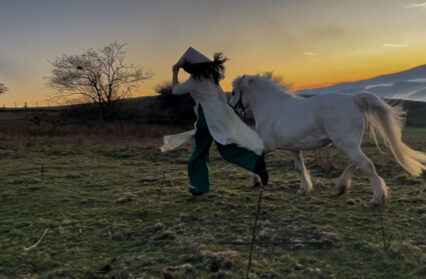Candy Bedworth takes a look at Roan/m, a mixed media exhibition of screenprints, photographs, textile and film by the artist Sarah Le Quang Sang (SLQS) on show at MOMA Machynlleth.
Roan/m is a multi-media exploration of the right to roam, land access and ethnic diversity in rural spaces. SLQS (Sarah Le Quang Sang) is a Franco-Vietnamese performance artist who lives in London and works in the UK and the UAE. She is a graduate of Goldsmiths University with an MA (Distinction) in Performance Making. In her current exhibition at MOMA Machynlleth, SLQS re-visits and pulls together three previous performative works: Find.ers.Keep.ers, Áo dài, and Walking Together.
Find.ers.Keep.ers explored the loss of bridleways across the UK, and includes photos, videos, maps and other ephemera from this project. This was apparently completed during a Covid lockdown, involving travel between parts of both England and Wales, hopefully not involving any Welsh rule-breaking!
Áo dài is a series of photographs documenting SLQS within rural locations, wearing traditional Vietnamese dress (the Áo dài, which she has screen-printed with maps). Here she reclaims her Vietnamese heritage whilst challenging traditional notions of who rides horses and where.
Walking Together is a film where SLQS explores the human relationship with horses on a meditative walk through Walthamstow Marshes. Throughout, SLQS questions the lack of diversity in the British landscape. Questions over who owns and has use of the landscape around us are investigated through her walking (and riding) art practice.
SLQS originally trained as an actress in Paris. The performative aspect of her work is most apparent in the exhibition photographs. The photographs look very much like film stills, and perhaps that isn’t a positive comparison. I overheard one visitor remark that the images looked like ‘a bad montage from a creepy film circa 2007’. If they weren’t so small, grainy and out of focus, this could be a fashion shoot or an expensive perfume campaign. They may be Instagram-worthy, but are they artistic enough for a gallery space? The printing, composition, framing, use of light and texture are poor. For spectacular photography work, head downstairs at MOMA to view the Snowdonia series by John Clow.
The screen prints are much more interesting, showing excellent printing skills and fabulous use of layering and colour. Alongside the screen prints we see two large mixed media poster-style images, describing what we assume was a difficult encounter with an English farmer and an injured, pregnant ewe in Ware. These are difficult: graphic language, in huge letters, displayed out of context, leaves the viewer uneasy, but also unable to fully grasp the narrative. Going to the StoryMaps on the artist’s website offers a little more detail that is not available in the exhibition. The scale and design of the posters is arresting, but the message seems to infer an innate cruelty to all farmers that I do not recognise from the rural landscape around Mid Wales.
SLQS works out of London, and much of the work here focuses on the South East of England. Some of the photographs are actually taken in Machynlleth, but the connections between Wales, SLQS’s Vietnamese heritage, and her position as a non-British woman of colour remain superficial and tantalisingly unexplored. This is Wales as ‘backdrop’. The meaning and relevance of Welsh heritage, language and culture for SLQS could have made for an interesting study. One visitor noted in the comments book that ‘a conversation rather than a sermon might engage people more effectively’. As an example of how this can work well, consider the Wales based Literature Across Frontiers project which works to develop intercultural dialogue. This offers prolonged and meaningful collaboration between artists from diverse backgrounds and landscapes.
Access to land in the UK is more limited than in most of Europe. But as we know from current political dialogue, the ‘UK’ is not one homogenous place. There are big differences between England and Wales – just the bare statistics on land use are telling. In England 37% of land is grassland, in Wales it is a whopping 72%. England is 30% arable land, Wales has just 3%. England is 9% woodland, Wales is 14%. These are two very different landscapes, in land use and ecology.
The UK certainly has more than its fair share of wealthy landowners in receipt of huge chunks of public money who treat visitors with utter disdain. The recent Dartmoor debacle where millionaire Alexander Darwall overturned an ancient right to wild camp saw mass protests. The hostile reception SLQS gets in her travels is truly shocking. One poster describes how someone threatens to shoot her horse if she returns.
The Right to Roam is an ancient custom that allows anyone to wander in open countryside, whether the land is privately or publicly owned. The Countryside and Rights of Way Act (CRoW) 2000 aims to more clearly identify and map open access land in the UK. So far in England they have managed a paltry 8%. And it is clear that SLQS definitely felt that push back – sometimes brutally. In Wales, our Assembly has identified 20% and they still going – hopefully in the right direction?
Performance art, by its very nature is hard to pin onto the gallery wall. We miss the immersive experience of witnessing and even participating in the performance. We don’t feel the wind, or smell the grass, or connect with the horses. We, the visitors, are left with mere shadows – photos, videos, notebooks, costumes. SLQS is mining fertile ground and her work on motherhood and birth is provocative. Equally, the question of who is included or excluded from our rural spaces is truly political, but this exhibition seems to somehow leave the visitor dissatisfied, slightly perplexed, and wanting more.
Roan/m from Sarah Le Quang Sang is on at MOMA Machynlleth until 10th June 2023.












